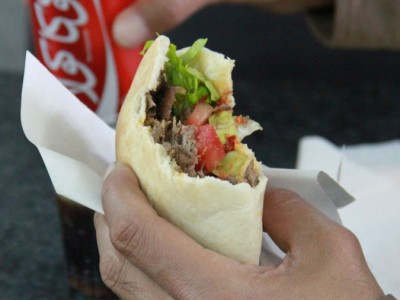
照片為 Joe mon bkk 個人作品,依據創用 CC BY-SA 4.0 授權使用
波斯料理的秘訣之一就是要了解,有些食物被認為是溫熱的,有些則被認為是寒涼的。那到底是什麼意思?全球之聲請了波斯料理無國界(Persian Fusion)網站的專家 Maryam Sinaiee 來為大家解釋這樣的概念:
Hot and cold don’t really refer to the temperature of food or its ingredients, they are rather descriptions of inherent properties in food ingredients that cause changes in the body.
The concept is based on Unani medicine [an ancient Greek medicinal tradition], according to which, individuals differ in nature too [with] some having a hot nature and others, cold. These attributes are associated with the color and temperature of the skin, temperament, etc.
溫熱與寒涼指的並不是食物或食材實際上的溫度,而是在描述食材本身的特性會對人體帶來什麼改變。
這個概念是源於尤那尼醫學(Unani medicine),[一種古老的希臘傳統醫學]。根據這樣的醫學傳統,每個人的體質也都不同──有的人是熱性體質,有的人則是寒性體質。這些屬性與皮膚的顏色及溫度、人的性情等等都有關聯。
在實際應用上,這表示如果你有被歸為「熱性」的健康問題,你就會吃點寒涼的食物來調和一下。反之亦然:如果你是「寒性」體質,吃太多寒涼的食物可能會讓你[的身體]更加失衡。
Sinaiee 解釋:
It’s quite elaborate and complicated so I’ll be giving you a very simplified version. Generally, high-energy, high-fat foods and most spices are considered hot. Many vegetables and grains, such as rice, are considered cold. The aim of the Persian cook is to balance hot and cold ingredients in a dish as components of a meal, or to correct the imbalance [that is] causing trouble to an individual, with food.
這說來是滿複雜的,所以我會給你一個很簡略的說法。一般而言,高能量、高脂的食物以及多數香料,都被認為是溫熱的;許多蔬菜和穀類(像是米)則被認為是寒涼的。一個波斯廚子的任務,就是要平衡一餐中每道菜裡熱性與寒性的食材,或是用食物去導正一個人[體內]失衡的狀況。
但是不是每個伊朗廚子都有張熱性與寒性食物表,或是每個用餐者的需求表呢?
Most Iranians, at least the older generation, just know these things or ask more knowledgeable people around them. When things are too difficult to address by home remedies, a traditional doctor may be consulted too.
For instance, everybody knows that chocolate and nuts are hot. So if a person has a rash, they’ll immediately tell him to hold off these foods. They might tell them to drink distilled chicory plant water, because it has a cooling effect on the body and will help get rid of the rash.
Coriander (cilantro) and sour plums are considered as cold. So if a person has fever, they’ll usually be given a coriander and plum soup (ash-e geshniz ba alu) to help with the fever.
多數伊朗人──至少是老一輩的伊朗人──都懂得這些,不然也會去問身邊比較懂的人。當狀況用家庭偏方無法處理的時候,大家也可能會去請教傳統的大夫。
比方說,大家都知道巧克力和堅果是熱性的。所以如果有人出疹子,他們會馬上叫他暫時不要吃這些東西。他們可能也會叫患者飲用蒸餾過的菊苣水,因為它有冷卻身體的作用,能幫助消疹。
芫荽(即香菜)與波斯青梅被認為是寒涼的。所以如果有人發燒,通常會被開給芫荽梅子湯(ash-e geshniz ba alu)來幫助退燒。
開始覺得有點道理了嗎?伊朗版的老祖母雞湯就是芫荽梅子湯。聽起來滿好吃的!Sinaeei 又說:
Traditional dishes are usually very balanced, though. Take fesenjoon, a scrumptious Persian stew of chicken or duck in walnut and pomegranate sauce. Walnuts are considered hot and pomegranates cold. Or rice with broad beans (fava beans) which is called baghali polo. Broad beans are considered as very cold, rice is cold too, so the dish is balanced with the addition of dill, a hot herb. The same goes with fish, a cold meat. It’s usually eaten with rice filled with herbs like dill, as well as with garlic, another hot ingredient. Yogurt, a cold food, will never, ever, appear alongside fish on a Persian table.
不過,傳統波斯菜通常都平衡得不錯。就拿一道美味的波斯燉菜(fesenjoon,用核桃與石榴醬汁燉的雞或鴨)來說好了──核桃被認為是熱性的,而石榴則被認為是寒性的;或者[來看看]被稱為 baghali polo 的蠶豆飯──蠶豆被認為是非常寒涼的,米也是寒性的,所以這道菜裡會加上蒔蘿(一種熱性的香草植物)來作為平衡。魚──寒性的肉──也是同樣的道理:通常魚會配上加了很多蒔蘿之類的香草植物還有蒜頭(另一種熱性食材)的飯一起食用。在波斯餐桌上,優格──屬於寒性食物──就永遠、絕對不會和魚一起出現。
換句話說,溫熱與寒涼的分類也有助於平衡餐食:
Persians love to eat tender, new season, romaine lettuce hearts with a syrup made from wine vinegar and sugar. That’s because lettuce is cold and the syrup’s heat will balance it.
波斯人喜歡吃新出的蘿蔓嫩芯配上酒醋糖漿。那是因為蘿蔓是寒性的,而這種糖漿的熱性能夠平衡掉這樣的寒涼。
不令人意外地,夏日與冬日都各有其必備的特殊食物──夏天吃寒涼的,冬天吃溫熱的:
Generally, hot dishes are served during the colder seasons. Normally, the rich and luxurious fesenjoon is saved for colder months, unless there is a big feast with many dishes to choose from. In summer, people usually tend to eat food of a colder nature — [dishes that are] less rich and made with lots of vegetables, cucumbers and yogurt.
一般說來,熱性的菜餚是在比較冷的季節吃的。按慣例,味道濃郁豐厚的核桃石榴燉雞(或鴨)是留到較冷的月分才吃,除非有什麼盛宴,需要有多道菜餚讓人盡情挑選享用。在夏天,大家通常偏好選擇比較寒涼的食物──使用大量蔬菜、黃瓜和優格,較為清淡[的菜餚]。
這種溫熱寒涼的原則也適用於甜點──而優格是用來平衡熱性食物的不二選擇:
After a meal with a cold dish like fish, a Persian family will usually serve a hot dessert made with lots of sugar, fat, and spices such as cinnamon. An example is khagineh, a sort of big pancake torn into pieces and drowned in a saffron-spiked syrup.
Yogurt is often served with or stirred into certain other dishes if they are hot. In my grandparent’s house, there was a bowl of ground, dried, bitter orange peel mixed with ginger (both hot ingredients) and sugar on the table too, as if all the precautions that my grandmother (a fabulous cook) took were not enough. My grandfather took a spoonful after most meals, presumably because he considered most food as cold.
在吃完有像魚這種寒性菜餚的一餐之後,波斯家庭通常會上一道多糖、高脂,還加了肉桂一類香料的熱性甜點。Khagineh── 一種把大煎餅撕成小片、浸在攙了番紅花的糖漿裡的點心──就是一例。
某些熱性菜餚常常會配上或拌入優格一起食用。在我爺爺奶奶家的餐桌上,也總有一碗混了乾燥苦橙皮碎末和薑(都是熱性食材)的糖,好像我奶奶──他是個很棒的廚師──[做菜時]種種細心斟酌都還不夠似的。我爺爺餐後幾乎都會舀上一匙,可能是因為他覺得多數食物都是寒性的。
照片可以吃嗎?
對於首次見識到伊朗大餐的人,其食物之豐盛可能會讓人不知所措──但那並不妨礙許多波斯料理愛好者在 Instagram 上分享他們的美食照。
在這張由 Instagram 用戶 shore.coli 所分享的照片中,有很多熱性與寒性食物能滿足各種需求:
Nature's bounty…from the sea to the mountains…an enjoyment of nature unique to Gilanis [people from the Northern Iranian province of Gilan]. Photo from one of our guests @vanilla.bakery.
大自然的賜予⋯⋯從山珍到海味⋯⋯[伊朗北部]吉蘭省人(Gilanis)獨享的大自然[恩賜]。我們一位客人在 @vanilla.bakery(香草烘焙坊)所拍攝的照片。
這張蠶豆飯──寒熱妙搭──的照片,是由 Instagram 用戶 foodie_express 上傳的:
M A H I C H E ??──在番紅花與番茄醬汁中慢燉至軟嫩的羊腿,配上蠶豆與新鮮蒔蘿滿滿的波斯米飯 #Persian(波斯) #Iran(伊朗) #mahiche(慢燉羊腿)#kebab(燉肉)#persianfood(波斯食物) #persianrice(波斯米飯) #nihari(帶骨燉肉)
這張蘿蔓芯蘸上薄荷醋糖漿(sekanjabin)的照片是由 Instagram 用戶 vida.rahimzadeh 所分享:
#Lettuce #sekanjabin [vinegar and mint syrup]…one of my best #memories ☺️?. Do you also share that feeling ?
#Lettuce(蘿蔓)#sekanjabin [薄荷醋糖漿]⋯⋯我最美好的 #memories(回憶)之一 ☺️?。你也感受到了嗎 ??
準備好自己來試試了嗎?
- 波斯料理無國界網站的 Maryam Sinaiee 在這裡分享了他令人垂涎的蠶豆飯食譜──羊腿佐蒔蘿蠶豆飯。
- 試試薑黃與番紅花(Turmeric and Saffron)網站的核桃石榴燉雞食譜。
- 無花果與榲桲(Fig and Quince)網站有個波斯甜蛋餅(或甜煎餅)的食譜。
- 我的波斯廚房(My Persian Kitchen)網站告訴你,怎樣調製搭配蘿蔓的薄荷糖漿。







